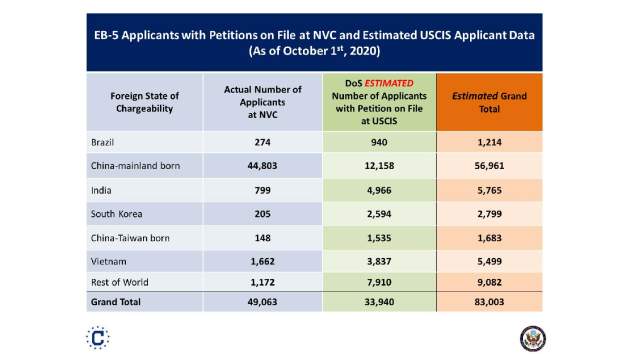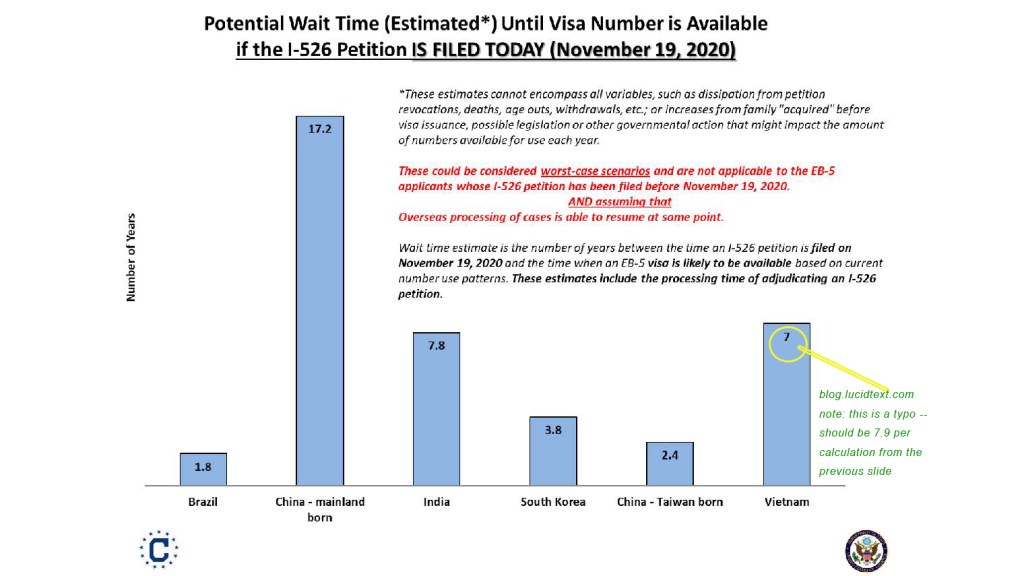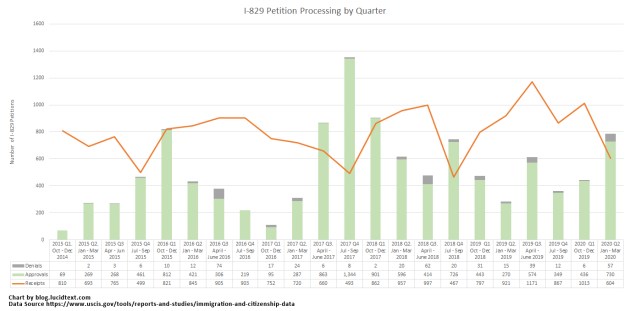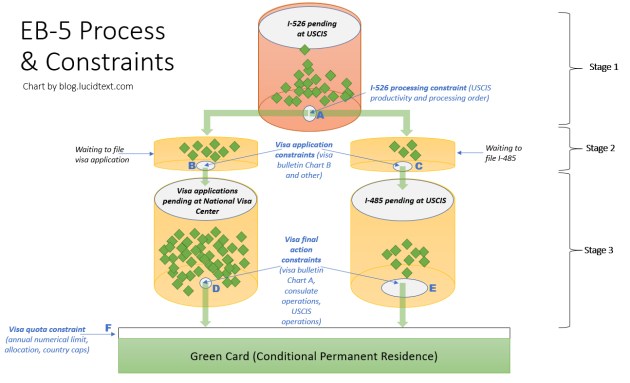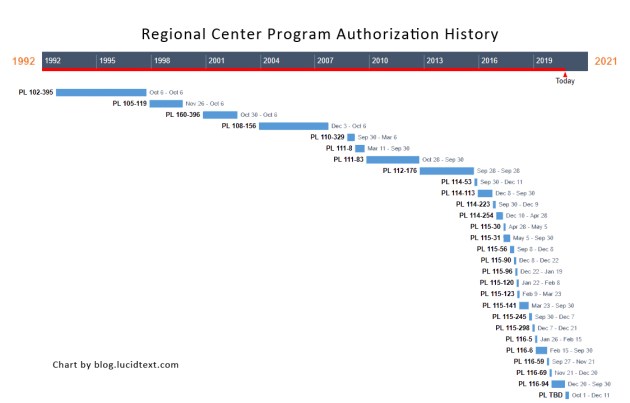We’re approaching the last chance to submit comments on the USCIS Policy Manual update on July 24 with “Clarifying Guidance for Deployment of Capital in Employment-Based Fifth Preference (EB-5) Category.” This page provides instructions for submitting comments, which are due “before” August 24. This post links to video of Carolyn Lee’s wonderful comment-writing workshop yesterday.
To prepare a rigorous policy comment for USCIS is tough hard work, especially for such a vexed issue as redeployment. See my draft comment copied below on the regional center geographic area issue. If you see any flaws, please reply to the post or email me so that I can revise. I’ll try to find time this week to prepare a comment for at least one other aspect of the redeployment issue.
*** DRAFT COMMENT ****
To: USCISPolicyManual@uscis.dhs.gov
From: Suzanne Lazicki, Lucid Professional Writing, suzanne@lucidtext.com
Subject: USCIS Policy Manual, Vol. 6: Immigrants, Part G: Investors, Chapter 2
Comment Regarding : USCIS Policy Manual Volume 6: Immigrants, Part G, Investors, Chapter 2, Eligibility Requirements [6 USCIS-PM G.2], Part 2, as updated on July 24, 2020 by “Clarifying Guidance for Deployment of Capital in Employment-Based Fifth Preference (EB-5) Category”
Specific Portion of the Document: My comment relates to two paragraphs added to the Policy Manual [6 USCIS-PM G.2], Part 2 on July 24, 2020, quoted as follows (including footnotes).
Consistent with precedent case decisions and existing regulatory requirements, further deployment must continue to meet all applicable eligibility requirements within the framework of the initial bases of eligibility, [Fn. 38: See 8 CFR 103.2(b)(1). See Matter of Izummi (PDF), 22 I&N Dec. 169, 175-6, 189 (Assoc. Comm. 1998). See Chapter 4, Immigrant Petition by Alien Investor (Form I-526), Section C, Material Change [6 USCIS-PM G.4(C)] including the same new commercial enterprise [Fn. 39 See INA 203(b)(5)(A), which refers to a single new commercial enterprise: “Visas shall be made available . . . to qualified immigrants seeking to enter the United States for the purpose of engaging in a new commercial enterprise.”] and regional center. [Fn. 40 See 8 CFR 204.6(j) which refers to a single regional center: “In the case of petitions submitted under the Immigrant Investor . . . Program, a petition must be accompanied by evidence that the alien has invested, or is actively in the process of investing, capital . . . within a regional center designated by the Service.” See 8 CFR 204.6(m)(7) which refers to a single regional center: “An alien seeking an immigrant visa as an alien entrepreneur under the Immigrant Investor . . . Program must demonstrate that his or her qualifying investment is within a regional center.”] In addition, because a regional center has “jurisdiction over a limited geographic area,” [Fn. 41 See Section 610(a) of the Departments of Commerce, Justice, and State, the Judiciary, and Related Agencies Appropriations Act of 1993, Pub. L. 102-395 (PDF), 106 Stat. 1828, 1874 (October 6, 1992), as amended] further deployment must occur within the regional center’s geographic area, including any amendments to its geographic area approved before the further deployment. The further deployment, however, does not need to remain with the same (or any) job creating entity or in a targeted employment area.
For example, if a new commercial enterprise associated with a regional center loaned pooled investment capital to a job-creating entity that created sufficient jobs through the construction of a residential building in a targeted employment area, the new commercial enterprise, upon repayment of the loan that resulted in the required job creation, may generally further deploy the repaid capital anywhere within the regional center’s geographic area (regardless of whether it would qualify as a targeted employment area) into any commercial activity that satisfies applicable requirements such as one or more similar loans to other entities.
Recommended Change, and Reason: The July 24, 2020 addition to 6 USCIS-PM G.2 Part 2 that addresses a regional center’s geographic area creates a substantive requirement. This language should therefore be rescinded. USCIS Policy Alert states that the July 24, 2020 addition intends to provide “clarifying guidance” only, and intended “not changing any substantive requirements.”
The added language about regional center geography in further deployment is not mere clarification, because it does not follow from existing regulatory requirements and precedent decisions. The authorities cited in Footnotes 38-41 in the Policy Manual update do not in fact justify a regional center requirement geography for further deployment, as demonstrated below.
The regulations and Matter of Izummi specify the reason for initial deployment within a regional center’s geographic area: indirect job creation. Since further deployment occurs after the job creation requirement has been met, these authorities do not justify assuming that a requirement that exists in the context of job creation should also be applicable to further deployment.
The Policy Manual grants that further deployment need not satisfy other initial deployment requirements linked to job creation: the requirements to deploy with a job-creating entity and within a Targeted Employment Area. The Policy Manual does not explain why regional center geography would be an exception to the previously unspecified but logical and predictable rule that deployment requirements linked to job creation do not apply after the job creation requirement has been met.
The community could hardly have predicted a redeployment requirement that is not theoretically grounded in the existing regulatory framework. If USCIS retains this contradictory new redeployment geography requirement with retroactive application, the industry will be punished for having previously acted in reliance on the regulations and precedent decisions.
If USCIS wishes to create a geographic requirement for further deployment, it should use an appropriate process for a substantive change. Otherwise, the Policy Manual could replace rescinded language with a clarification – consistent with the cited authorities – that further deployment need not be within the boundaries of the regional center.
Authorities:
Matter of Izummi states in pertinent part:
Under the Immigrant Investor Pilot Program, if a new commercial enterprise is engaged directly or indirectly in lending money to job-creating businesses, such job-creating businesses must all be located within the geographic limits of the regional center. The location of the new commercial enterprise is not controlling.
A petitioner may not make material changes to his petition in an effort to make a deficient petition conform to Service requirements.
… The definition of “regional center” in 8 C.F.R. § 204.6(e) requires that the economic unit be involved in “improved regional productivity.” 8 C.F.R. § 204.6(m)(3)(i) states that, in order to gain approval as a regional center, an entity must describe clearly how it will promote economic growth through “improved regional productivity.” If neither the credit company nor the export-related businesses are located in the regional center, it is difficult to see how the productivity within the regional center is being improved. As the subsidiary credit corporation’s actual and proposed loan activities benefit companies outside the geographical area covered by the regional-center designation granted in this case, the petitioner must establish direct employment creation; he cannot rely on indirect employment creation.
Comment: Footnote 38 in the updated 6 USCIS-PM G.2 cites Matter of Izummi in support of the point that “Consistent with precedent case decisions and existing regulatory requirements, further deployment must continue to meet all applicable eligibility requirements within the framework of the initial bases of eligibility, including … regional center.” But the citation does not support the point. Matter of Izummi does not indicate that a regional center’s geographic area is an applicable requirement outside the context of job creation.
In the passages quoted above, Matter of Izummi states that the requirement for location within the geographic limits of the regional center applies to job-creating businesses, and exists in connection with counting indirect job creation. So defined, this geography requirement does not logically apply to further deployment not in job-creating entities, and after the job creation basis of eligibility has already been met.
The NCE in the Matter of Izummi case deployed some investor capital outside the regional center’s geographic area. Matter of Izummi does not state that such initial was problematic in itself, but in connection with reliance on indirect job creation. Matter of Izummi states that if investor capital is originally deployed outside of the regional center’s geographic area, the consequence is that the investor must then meet the employment requirement with direct employment creation. Since even initial deployment can be outside a regional center’s geographic boundaries provided that it does not rely on indirect job creation, according to Matter of Izummi, how can the Policy Manual now require further deployment that does not rely on any job creation to be within the geographical area covered by the regional-center designation? Such a policy creates a requirement that not only did not previously exist for redeployment, but did not even previously exist as an unqualified requirement for the initial deployment.
Perhaps the July 24, 2020 addition to 6 USCIS-PM G.2 Part 2 assumes a post-job-creation pre-CPR regional center geography requirement based on assuming that further deployment outside regional center geography would necessarily constitute a “material change.” However, such a material change assumption is not warranted. Further deployment outside a regional center’s geographic area does not meet the Matter of Izummi definition of “material change” as quoted above: change made in an effort to make a deficient petition conform to Service requirements. If capital invested in Minnesota Regional Center LLC is initially deployed according to plan in Minneapolis, creates jobs in Minneapolis as described in the I-526 petition, and subsequently further deployed in Dallas, the Dallas deployment obviously does not address a deficiency in the initial petition. Furthermore, the Dallas deployment does not result in changed circumstances predictably capable of affecting the decision about I-526 eligibility (Kungys v. United States). The regional center geography requirement pertains in context of the job creation requirement, and the job creation basis of eligibility is not implicated in further deployment. Regional center geography could only be a material change issue for further deployment if it could be tied to an eligibility ground other than job creation. But the statute, regulations, and precedent decisions do not specify any regional center geography requirement divorced from job creation. Rather, they are united in linking deployment geography requirements to job creation eligibility requirements.
8 CFR 204.6(m)(7) states:
An alien seeking an immigrant visa as an alien entrepreneur under the Immigrant Investor Pilot Program must demonstrate that his or her qualifying investment is within a regional center approved pursuant to paragraph (m)(4) of this section and that such investment will create jobs indirectly through revenues generated from increased exports resulting from the new commercial enterprise. [Emphasis added to mark text omitted from the Policy Manual citation.]
Comment: Footnote 40 in the updated 6 USCIS-PM G.2 cites 8 CFR 204.6(m)(7) in support of a regional center geography requirement for further deployment. But the citation does not support the point. Footnote 40 places a period after the words “within a regional center” while omitting the second half of the cited sentence – the part that links the “within a regional center” requirement to the indirect job creation requirement. When viewed in full, 8 CFR 204.6(m)(7) does not clearly support a conclusion that a regional center geography requirement exists distinct from the job creation requirement. Matter of Izummi references 8 C.F.R. § 204.6(m)(3)(i) in the citation quoted above to support a conclusion about job creation requirement, with no suggestion of an abstract regional center geography requirement apart from job creation.
8 CFR 204.6(j) states:
(j) Initial evidence to accompany petition. A petition submitted for classification as an alien entrepreneur must be accompanied by evidence that the alien has invested or is actively in the process of investing lawfully obtained capital in a new commercial enterprise in the United States which will create full-time positions for not fewer than 10 qualifying employees. In the case of petitions submitted under the Immigrant Investor Pilot Program, a petition must be accompanied by evidence that the alien has invested, or is actively in the process of investing, capital obtained through lawful means within a regional center designated by the Service in accordance with paragraph (m)(4) of this section. The petitioner may be required to submit information or documentation that the Service deems appropriate in addition to that listed below. [Emphasis added to mark text omitted from the Policy Manual citation.]
Comment: Footnote 40 in the updated 6 USCIS-PM G.2 quotes a portion of 8 CFR 204.6(j) (the portion not underlined above) to support a regional center geography requirement for further deployment. But the citation does not support the point. Footnote 40 omits the context: 8 CFR 204.6(j) describes “Initial evidence to accompany petition.” 8 CFR 204.6(j) explicitly describes initial evidence to be submitted with the Form I-526 petition to demonstrate investment of lawful source of funds by an EB-5 investor in a NCE that will create jobs. 8 CFR 204.6(j) gives no reason to assume that these initial I-526 evidence requirements for the job-creating investment would also apply to a different context: a stage considerably after the I-526 filing that deals with reinvestment by the NCE of previously-deployed capital in an enterprise that need not create jobs.
Section 610(a) of Pub. L. 102-395, the statute that established the regional center program, states:
SEC. 610. PILOT IMMIGRATION PROGRAM.—(a) Of the visas otherwise available under section 203(bX5) of the Immigration and Nationality Act (8 U.S.C. 1153(bX5)), the Secretary of State, together with the Attorney General, shall set aside visas for a pilot program to implement the provisions of such section. Such pilot program shall involve a regional center in the United States for the promotion of economic growth, including increased export sales, improved productivity, job creation, and increased domestic capital investment.
This statute was subsequently amended by Pub. L. No 107-273, Sec. 11037(a)(3), 116, which states:
A regional center shall have jurisdiction over a limited geographic area, which shall be described in the proposal and consistent with the purpose of concentrating pooled investment in defined economic zones. The establishment of a regional center may be based on general predictions, contained in the proposal, concerning the kinds of commercial enterprises that will receive capital from aliens, the jobs that will be created directly or indirectly as a result of such capital investments, and the other positive economic effects such capital investments will have.
Comment: Footnote 41 in the updated 6 USCIS-PM G.2 cites Pub. L. 102-395 to support the claim that “In addition, because a regional center has ‘jurisdiction over a limited geographic area,’ further deployment must occur within the regional center’s geographic area, including any amendments to its geographic area approved before the further deployment.” But the point does not unambiguously follow from the citation.
Pub. L. No 107-273 describes Congressional intent for a limited regional center geography: to concentrate pooled investment such that capital investments from aliens will create positive economic effects, including jobs created directly or indirectly, in defined economic zones.
This intent is addressed with the initial deployment of alien investment, which occurs within the regional center and results in the required economic effects, including job creation, that are calculated at the I-526 stage and verified at the I-829 stage.
The statute does not suggest that Congress anticipated some aliens needing to create more economic impact than others within the regional center, based on the accident of their place of birth and excess visa demand. The statute does not suggest that Congress intended economic impacts dependent on serial deployment of an investment in multiple commercial enterprises within the regional center. By requiring further deployment to occur within the regional center’s geographic area, the updated Policy Manual creates a new eligibility requirement for compound economic zone impacts. The geography-specific requirements and impacts would be unique to investors from backlogged countries, and dependent on time delays that Congress did not intend.
Naturally, a defined economic zone would benefit from multiple deployments of capital investment where each repeat deployment is required once again impact that zone. Creating a geographic area requirement for further deployment would build on Congressional intent for the initial deployment, and could be economically beneficial (if practically problematic, as discussed in other comments). However, such a requirement does not currently exist, as demonstrated above. The existing statute as amended and interpreted by the regulations and Matter of Izummi does not include a regional center economic impact requirement separate from and subsequent to the job creation requirement. The language in the July 24, 2020 update to 6 USCIS-PM G.2 containing this requirement should therefore be rescinded. If USCIS wishes to create a geographic requirement for further deployment, it may do so with the proper process for substantive change.
